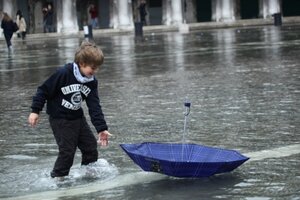Turn everyday objects into toys
Lots of household items make great toys. Just make sure they are sturdy, safe to put into a child's mouth, and too large to swallow.

A boy plays with an umbrella in the flooded Saint Mark's Square in Venice this past November. Just about anything can serve as a toy, as long as it's safe and sturdy.
Manuel Silvestri/Reuters/File
Whenever I watch my one year old at play, I can’t help but notice that there really are only a few requirements for entertaining him in a safe way.
The item needs to be fairly sturdy, as he can get mad and throw it. He’s one, so emotional control isn’t really part of the equation, nor is an understanding of any sort of “correct” way to play.
The item needs to have virtually no intricate parts. If it does, a one year old will break it. They are incredibly crafty little people who find new and inventive ways to dismantle items.
The item needs to be reasonably safe for him to put into his mouth, but not small enough to be swallowed. Inevitably, an infant or a young toddler will put things in the mouth. This means it shouldn’t be toxic or coated in a toxic paint, and it shouldn’t be very small lest it be a choking hazard.
The truth is, he’ll play with pretty much anything we put in front of him. He prefers that it makes noise or that he can make noise with it. He likes it if it’s something that his older siblings will also play with, particularly at the same time.
Most of the time, he just talks to the toy and holds it. He’ll sometimes put it in his mouth, almost to give it a taste. He’ll hit it on the floor or a table to see if it makes noise or if it changes shape. If it makes noise or changes shape, he’ll hit it over and over again. He likes to give the item to other people for a bit, but they need to give it back within ten seconds or so.
In other words, there are dozens of items already around our house that qualify perfectly for a toy for this child.
When you have a small child to be entertained, bust out the pots and pans and wooden spoons and let them go to town. Sure, it can be noisy. Sure, you can get tired of the racket. Still, there are few things that entertain a young child more than playing with the stuff that a grown-up uses, particularly when it makes noise and they’re given freedom to do with it what they will.
There have been countless times when I’ve just given my child a wooden spoon and a few pots and pans and just let him (or her) go to town on the kitchen floor. The child laughs. The child makes a lot of noise. The child pretends to stir things in the pot. The child flips the pots and pans over. The child will try to wear lighter items for a hat.
This is a perfect way to keep them entertained for a while as kitchen duties are taken care of. Afterwards, I just give the items a quick cleaning and they go right back in the cupboard until their next use.
Of course, this just scratches the surface of possibilities. With the older children, paper towel rolls have been converted into telescopes, toilet paper rolls have been converted into binoculars, empty soda bottles (with a bit of super glue, glitter, water, and food coloring) have been converted into oceans in a bottle, and large boxes have been converted into houses.
Your house provides an endless supply of items for children to play with without needing to buy them toys. That means you can certainly get away with less toy buying, which means you can provide more financial stability for your future and your children’s future.
This post is part of a yearlong series called “365 Ways to Live Cheap (Revisited),” in which I’m revisiting the entries from my book “365 Ways to Live Cheap,” which is available at Amazon and at bookstores everywhere. Images courtesy of Brittany Lynne Photography, the proprietor of which is my “photography intern” for this project.

